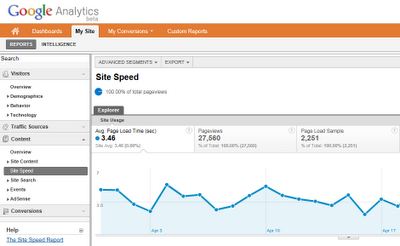Google’s new version of Google Analytics is currently available in beta — and you can bet we here at Ecreative Internet Marketing have been playing around with the new and improved Google Analytics. Their latest innovation in analytics was just announced on Google’s analytics blog yesterday: the site speed report with page load times.
The new Google Analytics will include a site speed report in the content section of your analytics. This will let you drill down to see not just the average page load speed, but also the load speed of each of your pages, average load speed of users based on browsers, geographical region, and traffic sources.
Site speed is important for multiple reasons. It’s a usability issue — users don’t like waiting for pages to load, and a consistently slow site can push users to abandon your website and look for the next one down their search results list. Knowing this, Google also takes site load speed into account in their ranking algorithm — a site that loads slowly is apt to rank more poorly, or at least have a more difficult time ranking well. So page and site load speed is definitely something that webmasters and SEO professionals should be paying attention to!
Google Analytics Code Modification for Site Speed
The site speed aspects of Google Analytics will only work with a modification to your Google tracking code, adding in this line to your asynchronous tracking code:
_trackPageLoadTime();
With this your entire asynchronous tracking code should look something like this:
<script type="text/javascript">
var _gaq = _gaq || [];
_gaq.push(['_setAccount', 'UA-XXXXX-X']);
_gaq.push(['_trackPageview']);
_gaq.push(['_trackPageLoadTime']);
(function() {
var ga = document.createElement('script'); ga.type = 'text/javascript'; ga.async = true;
ga.src = ('https:' == document.location.protocol ? '//ssl' : '//www') + '.google-analytics.com/ga.js';
var s = document.getElementsByTagName('script')[0]; s.parentNode.insertBefore(ga, s);
})();
</script>
Keep in mind, however, that this is currently only available on the Google Analytics beta. If you’re not participating in the beta, you’ll have to wait for the full version to be released. If you just can’t wait, you can sign up for the beta.







